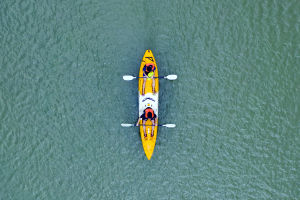Paragliding is an exciting airborne sport that allows people to soar through the sky with minimal equipment, experiencing the freedom of flight.
It is a non-motorized aviation activity where pilots control a lightweight, parachute-like gliding wing to fly.
Due to its accessibility, low cost, and unique perspective, paragliding has become an increasingly popular sport.
1. Basic Principles
Paragliding consists of two main components: the wing and the harness. The wing is the fabric structure that provides lift and stability, designed to open and inflate through the wind.
The harness is the gear worn by the pilot, connecting the pilot to the wing and allowing for precise control of the glider. Pilots control the paraglider by adjusting brake lines that are connected to the trailing edge of the wing. By adjusting the brake lines, the pilot can control the direction, speed, and descent.
Paragliding requires pilots to understand wind conditions, weather patterns, and basic flying principles. Pilots launch by either descending or taking off from a mountain, using wind to help inflate the wing. Once airborne, they control the flight direction and altitude by adjusting the brake lines, shifting their body weight, and utilizing updrafts (thermal currents). Thermals allow pilots to gain altitude and stay in the air for longer periods.
2. Types of Paragliding
There are several types of paragliding, each suited to different skill levels and adventure preferences:
1. Leisure Paragliding: This is the most common type, primarily for recreational flying. Leisure pilots typically fly in scenic areas, enjoying the views and the freedom of flight.
2. Cross-Country Paragliding: This advanced form of paragliding involves flying long distances by utilizing thermal currents. The distance can sometimes reach several hundred kilometers. Cross-country paragliding requires pilots to have an in-depth understanding of weather patterns and excellent flying skills.
3. Acro Paragliding: Acro paragliding involves performing aerial stunts and acrobatics. This type of paragliding requires high skill levels, with pilots performing maneuvers like rolls, spins, and other complex tricks.
4. Speed Flying: Speed flying is an extreme form of paragliding where pilots use smaller, faster wings to rapidly descend and fly close to the ground, often over steep terrain. This is a high-speed and thrilling activity requiring extensive experience and precise control.
3. Physical and Mental Benefits
Paragliding not only benefits the body but also has many psychological advantages. From a physical perspective, pilots use their core muscles to maintain balance and control of the paraglider, which helps improve strength and coordination.
From a psychological standpoint, flying brings a great sense of stress relief, as being in the air offers freedom and tranquility. The exhilaration of flight stimulates the release of adrenaline and endorphins, enhancing mood and creating a natural sense of joy.
4. Safety
While paragliding is a relatively safe sport, there are still inherent risks.
Reducing these risks depends on comprehensive training, proper equipment, and strict adherence to safety protocols. Pilots receive training on how to handle emergencies, such as turbulent air or equipment failure, and how to perform controlled landings.
Additionally, checking weather conditions before every flight is essential. Pilots must avoid flying in gusty winds, thunderstorms, or poor visibility. Wearing appropriate gear, such as helmets and protective pads, is also a basic safety measure.
Paragliding is an extraordinary sport that combines the thrill of flight with the beauty of nature, offering a unique perspective of the world. Whether experiencing the freedom of flight or enjoying the thrill of soaring in the sky, paragliding provides unparalleled sensory enjoyment.


